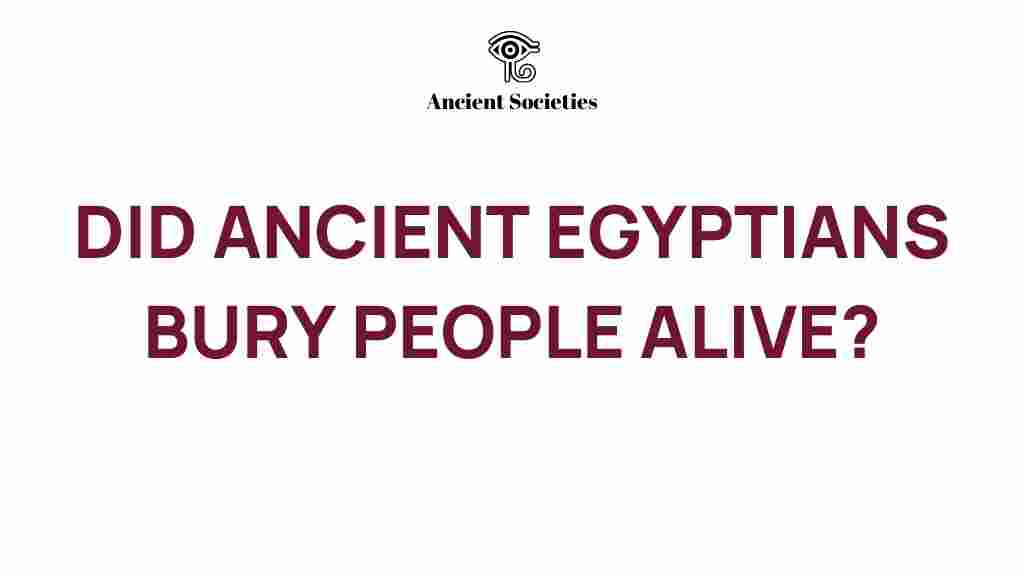Unraveling the Mystery: Did Ancient Egyptians Bury People Alive?
The ancient Egyptians are renowned for their elaborate burial practices, which have fascinated historians, archaeologists, and enthusiasts alike. Their complex approach to death and the afterlife is steeped in rituals aimed at ensuring immortality for the deceased. However, one of the more sensational claims surrounding these practices is the idea that ancient Egyptians sometimes buried people alive. This article delves into the myths, historical evidence, and archaeological findings to unravel this mystery.
The Significance of Burial Practices in Ancient Egypt
Burial practices among the ancient Egyptians were not merely about disposing of the dead; they were a profound reflection of their beliefs regarding life, death, and the afterlife. The ancient Egyptians believed in an afterlife that was a continuation of earthly existence, and thus, proper burial was essential for ensuring the deceased’s immortality.
Key elements of these practices included:
- Mummification: The process of preserving the body to prevent decay.
- Tombs: Elaborate structures designed to house the deceased and their belongings.
- Rituals: Ceremonies performed to honor the dead and guide them to the afterlife.
Myths Surrounding Burials and Human Sacrifice
Throughout history, various myths have arisen regarding ancient Egyptian burial practices. One particularly intriguing idea is the notion of live burial or human sacrifice. Some stories suggest that servants or even family members were buried alive alongside pharaohs to accompany them in the afterlife. However, these tales often stem from misunderstandings or exaggerations of ancient texts and practices.
To understand the truth behind these myths, it is essential to examine the historical evidence and the context of ancient Egyptian culture.
Historical Evidence: What Do We Know?
Archaeological findings provide vital insights into the burial practices of the ancient Egyptians. While it is well-documented that they practiced mummification and constructed elaborate tombs, concrete evidence of live burial is scarce.
- Literary Sources: Ancient texts, such as the Pyramid Texts and the Book of the Dead, provide insights into the beliefs surrounding death and the afterlife but do not explicitly mention live burials.
- Archaeological Discoveries: Excavations of tombs and burial sites have revealed numerous artifacts and remains, but instances of live burials have not been substantiated.
- Ritual Context: While some rituals involved the killing of animals or the sacrifice of goods, these were primarily intended to appease the gods or provide for the deceased, rather than to accompany them with living beings.
Step-by-Step Analysis of the Evidence
To thoroughly analyze the claims of live burials in ancient Egypt, we can follow a systematic approach:
- Examine the Sources: Look at various historical texts and archaeological reports to identify credible references to burial practices.
- Evaluate the Context: Consider the social and religious context of the time, which might explain the rituals surrounding death.
- Analyze Archaeological Finds: Investigate tombs and burial sites for evidence of human remains that could suggest live burials.
- Consult Experts: Engage with archaeologists and Egyptologists to gain insights into the interpretations of existing evidence.
Common Misinterpretations and Troubleshooting Tips
Many misinterpretations arise from sensationalized accounts of ancient Egyptian practices. Here are some common misconceptions and tips to navigate them:
- Misconception: All tombs contained human sacrifices.
Tip: Many tombs contained items for the afterlife, but evidence of human sacrifice is minimal. - Misconception: Mummification was solely for the elite.
Tip: While the wealthy received more elaborate mummification, commoners were also mummified, albeit less extravagantly. - Misconception: Live burials were a common practice.
Tip: Most evidence points to burial as a respectful process, not a brutal one.
Archaeological Insights and Case Studies
Several archaeological sites have provided insights into ancient Egyptian burial practices. Noteworthy examples include:
- The Valley of the Kings: Home to many tombs of pharaohs, this site has revealed extensive burial practices but no evidence of live burials.
- The Tomb of Tutankhamun: This tomb contained a wealth of artifacts intended for the afterlife, again without signs of human sacrifice.
- Saqqara: The vast necropolis has uncovered numerous burial sites, illustrating the practices of mummification and tomb construction.
Through these case studies, we can observe that while the ancient Egyptians had a rich tapestry of rituals surrounding death, the notion of burying people alive appears to be more myth than reality.
Conclusion: The Legacy of Ancient Egyptian Burial Practices
In conclusion, while the idea that ancient Egyptians buried people alive makes for a sensational story, the evidence does not support such claims. Their burial practices were deeply rooted in their beliefs about immortality and the afterlife, focusing on honoring the deceased and ensuring their safe passage into the next world.
As we continue to explore the mysteries of ancient Egypt through archaeology and research, it is crucial to differentiate between myth and historical fact. The ancient Egyptians’ dedication to their burial practices remains a testament to their rich culture and enduring legacy.
For further reading on ancient Egyptian burial practices, you can explore this comprehensive guide. Additionally, to learn more about the myths surrounding ancient Egypt, check out this informative article.
This article is in the category Archaeology and created by AncientSocieties Team
